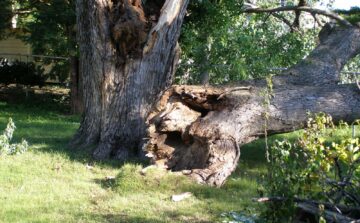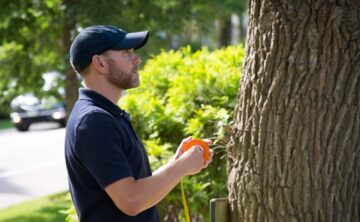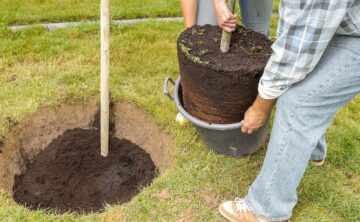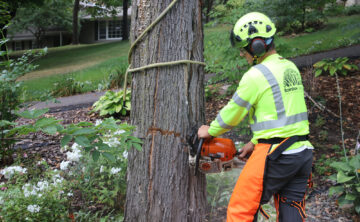How to Handle Tree Storm Damage
Seeing a beloved tree toppled over or broken after a storm in Minnesota can overwhelm any homeowner. It might be hard to know where to start cleaning up, especially if your home has been damaged too. You may even have unknown businesses come to your door selling “emergency” tree work.
Many homeowners want to jump in and do things on their own. However, when it comes to trees, short-term decisions, including improper removal of partially broken limbs, can have long term consequences to the health of your tree. Some jobs are safe for do-it-yourselfers, such as removing small broken branches, but larger jobs can be dangerous. These tips from our tree experts can help you make the best decisions, and avoid common pitfalls, after storm damage.

Survey the damage after a storm
The first step afer your trees sustain any storm damage is to take a look around. A few tips to keep in mind are:
- Be aware of hazards like fallen power lines and broken tree limbs, which may be hanging overhead. Fallen trees or large tree branches can easily hide electrical hazards.
- Contact your insurance provider or take pictures of damaged property before moving any part of a tree that has hit a structure.
- Don’t get taken advantage of by storm chasers that may knock on your door offering removal services. Verify insurance, licensing information, and an arborist’s ISA credentials from anyone selling tree services following a storm.
- This article offers tips on how to hire an arborist.
Can a damaged tree recover?
Many trees can be pruned after storm damage, however in some cases saving a beloved mature tree isn’t an option. A tree may need to be removed if:
- it loses more than a third of its overall canopy volume as it may become stressed and decline in health.
- the remaining parts are structurally unstable and at risk of breaking later.
- the tree is too disfigured (in other words, you can’t stand to look at it).
If none of these criteria apply to your trees, there’s a good chance they can recover! But how do you repair a storm damaged tree? Once you’ve verified the site is safe, prune away jagged or broken smaller branches back to their main branch—leave the removal of larger or main branches to an ISA Certified Arborist. Patches of damaged bark can be repaired by using a sharp knife to remove the rough edges of wounded areas; smoothing these edges helps keep harmful fungus and insects from further damaging the tree.
The type of damage can affect how and when your trees can recover. Some of the most common storm damage we see in Minnesota includes:
Heavy snow or ice storms can cause broken branches or sometimes even the entire tree to fall. While there is no coming back from a downed tree, small breaks can be pruned back to the larger limb, while larger broken branches should, as always, be handled by a credentialed professional.
Bent branches and bowed trees can look like a concern, but if the tree is healthy, there is usually no issue with leaving them alone until the snow and ice melt. Eventually they will return back to their regular shape.
Storm damage caused by high winds often results in snapped tops or twisted branches that haven’t quite fallen. Twisting can cause branches to split and require pruning by a professional as soon as possible. Wind can also strip foliage from the tree which, while it may make the tree look strange for a while, is generally not too big of an issue if the tree is otherwise healthy.
Lightning storm damage can be devastatingly total, but some trees do recover. When lightning strikes trees, it instantly turns all the moisture inside to steam. This process can result in obvious explosion damage, but can also severely harm the tree’s interior. Even if your tree remains standing after being struck, it’s wise to have a trained arborist help check for potentially fatal internal damage.
If your tree survives being struck, pruning away broken limbs, water to help the tree regain lost moisture, and closely monitoring health through the next growing season.
In most cases, hail can damage a tree’s foliage, small limbs, and bark — especially when paired with high winds. More often than not, a healthy tree will recover on its own from this kind of damage. However, if a majority of the leaves have been stripped away by hail or there are large gashes in the bark, it’s a good idea to closely watch for fungus or insect issues until the canopy can regrow and the bark can heal.
Assessing tree risk
Not every damaged tree needs to be removed. If you have concerns, call an ISA Certified Arborist and ask if they can perform a tree risk assessment. The arborist will make recommendations based on their findings along with your goals and concerns. The property owner is responsible for following professional recommendations about the tree.
Questions to consider:
- If a branch failed, what would it hit?
- Is there a valuable structure or vehicle under the tree?
- Is it over a high traffic area where people walk or play?

Can storm damage be prevented?
While even the healthiest of trees sustain damage during a severe storm, those with structural issues have a greater chance of long-term problems or may require removal. Follow our expert tips to keep your mature trees storm-ready!
- Prune your trees. Wind resistance typically causes damage to the tree’s trunk and branches. Along with thinning out the top of the canopy, pruning will also help remove dead, diseased, and damaged branches that could fall during a storm.
- Check those roots. Leaning trees could mean your tree has a root problem. Have an ISA Certified Arborist check your roots to ensure their structure provides stability. If your roots are currently strong, further protect them by using a wide ring of mulch around the base of your tree. This helps protect roots from damage and helps get water and nutrients through the soil to the roots.
- Look for cavities. Cavities don’t just apply to your teeth; they also apply to your tree. If there is any open cavity or decay your tree might be weak, hollow, and easily damaged. Have your Certified Arborist check your tree for a professional opinion
Additional resources
- Learn about tree risk assessments from the Tree Care Industry Association (TCIA).
- Learn about tree first aid from the Arbor Day Foundation.
Do you have storm damage in the Minneapolis area?
Rainbow Treecare is licensed and insured, and has over 45 ISA Certified Arborists on staff. You can count on us to handle your storm damage while ensuring the safety of you and our crew!
Other items you may be interested in:

Tree Planting Basics for Minnesota Homeowners
There’s an old saying, “The best time to plant a tree is twenty years ago.” While it makes a humorous point about how long it

Be an Informed Tree Pruning Customer
We all want the best for our trees. They are a valuable part of the landscape, and we feel a strong attachment to them. Finding

Tree & Stump Removal
Tree and Stump Removal Services in Minneapolis As the largest, locally-owned tree removal company in the Twin Cities Metro, you can count on the experts



